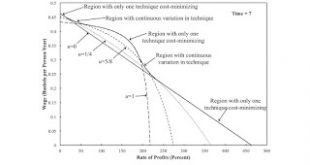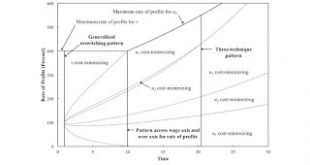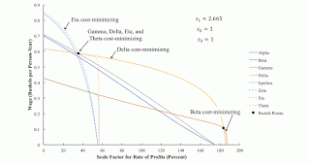Recurrence Of Techniques Without Switch Points I have built on my previous post in a writeup: Abstract: In certain models of commodities produced by means of commodities, the choice of technique is analyzed by the construction of the wage frontier. This article presents a numeric example of a continuum of wage curves tangent at a switch point. Technological progress leads to the recurrence of techniques. No switch points then exist, but the cost-minimizing technique varies continuously...
Read More »Economists Critical Of Mainstream Economics Not Going Into Academia
Here are three books I have read: Paul Ormerod (1994). The Death of Economics. St. Marin's Press. Stanley Wong (1978, 2006). Foundations of Paul Samuelson's Revealed Preference Theory: A Study by the Method of Rational Reconstruction. Routledge J. E. Woods (1990). The Production of Commodities: An Introduction to Sraffa. Humanities Press. These authors have two things in common. All three were critical of some aspects of mainstream economics. And they all ended up in business. Looking at...
Read More »A Generalized Reswitching Pattern
Figure 1: Switch Points Varying with Time1.0 Introduction This post presents a perturbation of a fluke switch point. At this switch point, the wage curves for four techniques are tangent. In the jargon I have been inventing, this is another four-technique, local pattern. In other words, a perturbation of appropriately selected parameters - for example, coefficients of production - changes the sequence of wage curves and switch points on the wage frontier. The perturbation can be viewed as...
Read More »Update To A Start On A Catalog Of Switch Point Patterns Of High Co-Dimension
I have been looking at patterns of switch points. A pattern is a configuration of switch points helpful for perturbation analysis for the choice of technique. I am curious how the switch points and the wage curves along the wage frontier can alter with parameters, in a model of the production of commodities. Such a parameter can be a coefficient of production; time, where a number of parameters are functions of time; or the markup in an industry or a number of industries. A normal form...
Read More »Workers Benefiting From Increased Markups In Selected Industries
Figure 1: Variation in Switch Points with the Markup in the Iron Industry1.0 Introduction I finally use the tools of pattern analysis that I have been inventing to tell a practical story. I build on the example which I began in my previous post. Workers would be better off if an increase in wages led to greater employment, not less. A long-period change in relative markups among industries can result in firms in some industries obtaining a greater rate of profits at the expense of firms...
Read More »One Technique Replacing Another: An Example
Figure 1: The Wage Frontier at a Four-Technique Patterns1.0 Introduction This post presents another numerical example of one technique replacing another, along the wage frontier, with a perturbation of a model parameter. In a previous post, I identified three sequences of patterns of switch points in which the wage curves for one technique replaces the wage curve of another. In one of these sequences, a three-technique pattern removes the middle technique from three techniques with wage...
Read More »One Technique Replacing Another
Figure 1: One Way One Technique Can Replace Another The wage-rate of profits frontier (or wage frontier) is calculated with prices of production, given the techniques of production, available in the economy, for producing a given output. Suppose at one point in time, the techniques that lie along the wage frontier consist of the Alpha, Beta, and Gamma techniques, in order of an increasing rate of profits. As time passes, technical innovation alters coefficients of production, including for...
Read More »Marx Versus Classical Economics
Marx can be read as both a continuation and a critique of classical economics. A not-too-radical reading might emphasize his claim to find distinctions in economic theory glossed over by classical economists such as Adam Smith and David Ricardo. According to Marx, classical economists (as opposed to vulgar economists such as Frédéric Bastiat, Jean-Baptiste Say, and and Nassau William Senior) penetrated beneath surface phenomena to reveal the anatomy of capitalism. A more radical reading...
Read More »Another Way Reswitching Can Appear
Figure 1: Wage Curves for a Reswitching Example1.0 Introduction This post illustrates another fluke case. In this example economy, two techniques exist for producing a net output of corn. The wage curves for the two techniques have two switch points. One switch point is on the wage axis, corresponding to a rate of profits of zero. The other is on the axis for the rate of profits, corresponding to a wage of zero. This example is a fluke in two ways. In the jargon I have been inventing, it...
Read More »Books That Seem Interesting
I am thinking of maybe buying one of these: Roger E. Backhouse (2017). Founder of Modern Economics: Paul A. Samuelson: Volume 1: Becoming Samuelson, 1915-1948 Robert Leonard (2012). Von Neumann, Morgenstern and the Creation of Game Theory: From Chess to Social Science, 1900-1960 Philip Mirowski and Edward Nik-Khan (2017). The Knowledge We Have Lost in Information: The History of Information in Modern Economics Angela Penrose (2017). No Ordinary Woman: The Life of Edith Penrose Yanis...
Read More » Robert Vienneau: Thoughts Economics
Robert Vienneau: Thoughts Economics






